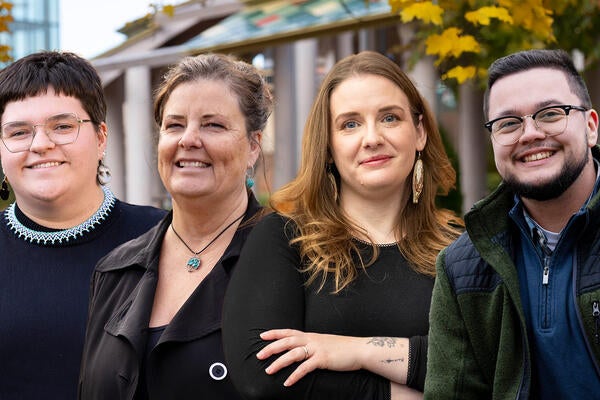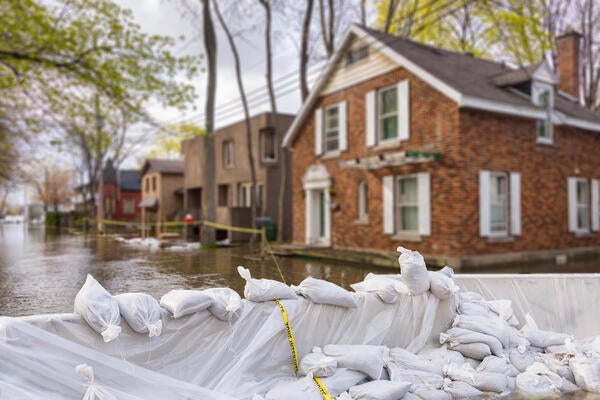
Remembrance Day: Grad researchers examine soldiers’ letters and lives
Many soldiers were 22-years-old when they died—the same age students are when they graduate from university

Many soldiers were 22-years-old when they died—the same age students are when they graduate from university
By Taylor Legere University Relations While Remembrance Day gives us the opportunity to honour Canadians who have died in war, there are two graduate students at the University of Waterloo who are remembering soldiers every day through their scholarly research.
While Remembrance Day gives us the opportunity to honour Canadians who have died in war, there are two graduate students at the University of Waterloo who are remembering soldiers every day through their scholarly research.
Sarah Oeste and David Alexander, both master students in the Department of History, were inspired by battlefield tours to learn more about the individual stories of those who fought in the First and Second World Wars.
 Oeste’s research focuses on the connections between soldiers and their families through the lenses of gender and class.
Oeste’s research focuses on the connections between soldiers and their families through the lenses of gender and class.
In particular, Oeste is focusing on the Canadian soldier, Charles Richardson, through reading the letters exchanged between him and his family and friends.
Oeste was initially drawn to studying Richardson after presenting about him at his grave site near Vimy Ridge while participating in the Canadian Battlefield Tour.
“Richardson was 25 and I’m 22 so there wasn’t too much of an age difference there and he went to college so I could relate to him in some ways,” said Oeste.
Richardson was born in Grenfell, Saskatchewan and studied at the Manitoba Agriculture College before enlisting in 1915. He served until April of 1917 when he died at Vimy Ridge.
Although Oeste developed an interest in Canadian war history at a young age, it was attending the battlefield tour that sparked her interest in soldiers’ letters for her thesis.
“Being able to learn about the battlegrounds was great and I think that participation in commemoration was really good for me as well,” said Oeste. “I was able to mentally connect the battlefields to the history and to the individuals who were involved.”
Oeste considers Remembrance Day an important aspect of Canadian history. “I think remembering that soldiers died … and they died on a massive scale, is important to understanding our world today,” said Oeste. “…understanding the individual impact of the war on each soldier is really important to me as well.”
Richardson’s letters can be viewed on the Canadian Letters and Images Project website. The project is an archive of letters and images aiming to preserve the story of Canadian war experiences for future generations.
Alexander was inspired by participating in the War and Canadian Experience in the Netherlands battlefield tour, organized by the University of New Brunswick’s Gregg Centre for the Study of War and Society.
 His research focuses on the war dead from Owen Sound Collegiate Vocational Institute – where he taught history for 32 years before beginning a master’s degree at Waterloo. He hopes to illustrate the different experiences of the alumni who fought during the First World War compared to the Second World War.
His research focuses on the war dead from Owen Sound Collegiate Vocational Institute – where he taught history for 32 years before beginning a master’s degree at Waterloo. He hopes to illustrate the different experiences of the alumni who fought during the First World War compared to the Second World War.
Before officially beginning his research, Alexander had already begun research with the help of his former students. “It’s rewarding that younger Canadians have an interest in finding out about individuals who once attended the same school they did,” said Alexander. “I think it’s important to view this history through the lens of a small community.”
For Alexander, Remembrance Day is a time to reflect on both his own family members who took part in past wars as well as the former Owen Sound Collegiate students he is studying. Many of the high school’s alumni were around 22 years old at the time of their deaths, — the same age that many current Waterloo students are when they finish their undergrads.
“What impact could they have had on their community and country had they been able to come back? Many of them were certainly bright individuals,” said Alexander. “…they might have made a huge difference.”
“I think of the families that were forever changed by the loss of loved ones. I reflect on that,” continues Alexander. “I reflect on all the loss that war has brought this past century on all peoples. Whether they are the vanquished or the victors.”
The University of Waterloo’s Chaplain’s Association invites students, faculty, and community members to attend the Remembrance Day service to take place on Friday November 10th from 10:45pm to 11:15am in the Student Life Centre Great Hall.
The service will include prayers for peace from variety of faith leaders, a performance from the University Chamber Choir, and two minutes of silence at 11 am.

Read more
Researchers awarded funding to investigate ecology, climate change, repatriation, health and well-being through cultural and historical lens

Read more
Meet five exceptional Waterloo graduate students crossing the convocation stage as Class of 2025 valedictorians

Read more
Waterloo researchers propose solution to help communities escape the costly cycle of flood damage and rebuilding
The University of Waterloo acknowledges that much of our work takes place on the traditional territory of the Neutral, Anishinaabeg, and Haudenosaunee peoples. Our main campus is situated on the Haldimand Tract, the land granted to the Six Nations that includes six miles on each side of the Grand River. Our active work toward reconciliation takes place across our campuses through research, learning, teaching, and community building, and is co-ordinated within the Office of Indigenous Relations.